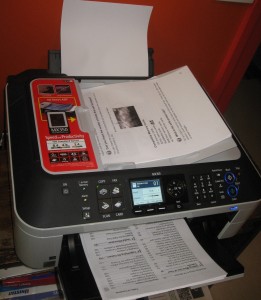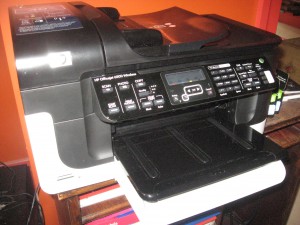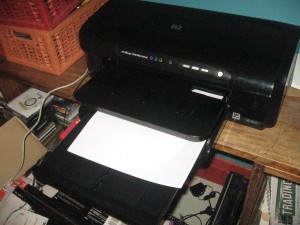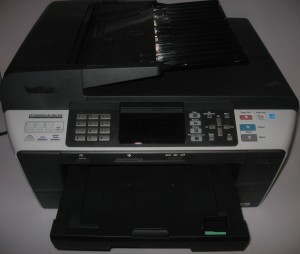Introduction
Your may be operating an old printer that is “on its last legs” or you may be considering a printer for your new computer setup. At this point, you are thinking of which printer to purchase as your next printer.
The printer market is divided between two classes of printer user – the consumer which represents a typical household; and the small-business market which represents small organisations and home-office users who use the printer as part of telecommuting. I am not focusing attention on equipment pitched at “enterprise” users because these units are typically either leased or purchased under operation-specific plans and have too much functionality that is out of the scope of this buyer’s guide and Website.
Why prefer a network-enabled printer
When you have a small network in place at home or in your small business, it is now a good idea to move away from the cheaper “desktop-only” printers and multifunction printer-scanner units which are typically connected to one computer using a USB cable, and move towards a network-enabled printer. These printers connect directly to your home or small-business computer network and are in a position to share their printing or other resources without you needing to have a computer running all the time for this to happen.
Sure, you could connect a desktop printer to a network print server, which is now one of many functions provided by most routers or network-attached storage units. But on the other hand, a lot of the desktop-only units come with software that makes them totally dependent on their host computer and they don’t work well with network print servers. In the case of multifunction printer-scanner combos, you may only be able to print to the device’s print mechanism – you may not be able to gain access to the scanner, fax functionality or secondary storage.
Multifunction printer-scanner combo devices also benefit from network connectivity because they can allow you use their other resources from any computer in the network. There is even the ability to “push-scan” documents to any particular computer on the network from the printer’s control panel as long as you have the manufacturer’s software on that computer. This is because there isn’t a standard ability to list all available scanning endpoints on a network as yet. Some units can also “mount” the camera-card slots in the printer as network-shared disk drives so you can import the pictures to the computer for “processing”.
The network-enabled printer can work well with the “new computing environment” because the laptop computers that connect wirelessly to the home network can send their print jobs through that network to the printer. This avoids the need to locate the printer and connect up the USB cable to your laptop every time you want to print something out. The printer would be connected to the network via whatever network medium works best for the situation whether it be Wi-Fi wireless; blue Ethernet cable, or HomePlug or MoCA “existing wires” technology. This also allows you to locate the printer wherever you want to, as long as it is connected to your network and to power.
The main exception to this rule would be a portable printer like Canon’s PIXMA IP100 which is designed for use as an “on-the-go” printer for a laptop user; or a printer that services a particular desktop computer’s computing needs.
Printer Device Classes
Consumer printers and multifunction devices
Examples: Canon PIXMA MX-350 and MX-870, HP Photosmart series
These are printers and multifunction devices that are pitched at households to use primarily for printing “happy snaps” and other casual short-run print jobs, with occasional large print runs for homework projects and the like. They are often sold through the big appliance chain stores like Best Buy, JB HiFi and Harvey Norman and typically are finished in a cabinet that is attractive for home use. This is a way where manufacturers try to please the “woman of the house” with this class of printer by emphasising the machine’s beauty.
This class of printers always uses inkjet technology and the printing system in most of these printers is typically optimised for printing of photographs. This is typified through the use of photograph-optimised inks including five or six ink cartridges in some machines. In most of these machines, the paper-feed mechanism is optimised to handle “snapshot” prints with some machines like the HP Photosmart Premium Fax having a separate paper tray for 4”x6” paper.
The downside of this is that these printers are costly to run and, in most cases, they have a low duty cycle which will cause reliability problems for business users who run off many documents.
It is also worth knowing that most of the premium devices in this class are pitched as “home-office” printers and have business-ready functionality like integrated fax functionality or high-speed operation. This is although they are optimised for photographic printing and use the expensive consumer-grade photo inks rather than business-grade large-capacity inks.
Small-business printers and multifunction devices
Examples: Canon LaserShot series, HP OfficeJet series, HP LaserJet series
The printer equipment that is pitched at the small-business market is optimised for speed, efficiency and economy for a high duty cycle.
Most units will use inkjet printing although some models may use a laser or LED xerographic printing technology and one brand, namely Fuji Xerox, uses a “solid-ink” technology similar to how crayons work. This is although the output speed and quality of the inkjet printers is approaching that of equipment based on these other technologies.
There is much less importance on photo quality with most printers in this class because they are optimised for printing business documents most of the time. Let’s not forget that the colour inkjets in this class can do a good quality job of printing photos when given A4 or similar size paper. As well, they won’t have support for “snapshot” paper for use with printing “happy snaps”. Some manufacturers won’t provide a colour display on their low-end small-business models, which then will make it hard to print selected images from a digital-camera’s memory card, although they can print a DPOF print order that you determine on the camera from the camera’s memory card.
Network connectivity and setup
Connectivity
Most network-capable consumer-grade multifunction printers and a few small-business multifunction printers can connect to 802.11g WPA-PSK wireless network either with a built-in wireless network adaptor or a wireless network adaptor sold as an optional accessory. Some of the newer models in each class will properly support 802.11n wireless networks and may work with dual-band networks.
The mid-range and premium consumer equipment and all of the small-business equipment will have an Ethernet socket as a network connectivity path. This will provide increased connection flexibility such as the ability to use the “no-new-wires” technologies like HomePlug powerline or MoCA TV coaxial-cable networks as well as direct connectivity to a router’s or network switch’s Ethernet socket.
Wireless-network setup
Most of the economy consumer-focused models will require direct USB connection to a PC that is running manufacturer-supplied software to allow a user to configure them for most wireless networks. An increasing number of these machines may support WPS-based connection setup from the device’s control panel.
Better-equipped models will allow wireless-network setup for most home and small-business wireless networks at the unit’s control panel. usually with an “SMS-style”, “pick-n-choose” or virtual-keyboard text-entry method for entering WPA-PSK passphrases. Most of these models will not support WPA-Enterprise networks which are based around access to the wireless network based on user name and password credentials.
Network functionality
All of the machines will support network printing and if they have scanners, they will support network scanning. This will be in the form of allowing PC-initiated scanning to be started from the operating-system interface or manufacturer’s software, or device-initiated scanning as long as the host computer has the manufacturer’s software running.
Fax-equipped units can allow a user to send a fax via the network using the printer’s “fax” driver and some of the machines can send a fax to one of the computers in the network as long as the computer is on and running the manufacturer’s software.
Due to the cost-conscious manufacturing practices that exist in the consumer and small-business class of printers, there isn’t the likelihood of the printers supporting “on-device” print-job spooling where the print queues are held at the printer. Instead, the computers that prepare the jobs have to hold the jobs on their hard disks until the printer has finished printing the current job. There may be situations where there will be a “rush to the gate” to get a print job going when a print job is complete and two or more computers have pending print jobs. This feature could be made more available to this class of printer now that the cost of flash memory or hard-disk storage that is enough for this purpose has come in to ridiculously-cheap territories.
The network printing appliance
A new trend that is emerging especially with consumer equipment; and has been spearheaded by Hewlett-Packard is the ability for the printer to become an Internet-connected computer-independent “printing appliance” rather than a printer for computers on the local network. This is aided with a dedicated Web-based “online printing” portal created by the printer manufacturer where you manage this functionality. Here, the printer can be set up to print emails forwarded to a specific email address associated with that unit, print files uploaded to a particular Web page or print from special Web-based applications that are loaded on it.
Large-sheet printing
You may want to invest in a network printer that can work on paper sizes that are A3 or bigger, perhaps to print promotional material on large sheets of paper or to “run-off” hard copies of large spreadsheets.
In some cases, this may become more ecessary as organisations that you work with supply their “on-site” promotional material in a “download-to-print” form. This is where you download PDF files of the promotional material from a Website or receive the PDF files as an email attachment, then you print these PDF files out. For these organisations, it is a cheaper option because they don’t have to print out and deliver or post the material to the sites where it is needed and they can focus the material to particular locations in an easier and quicker manner.
At the moment, there aren’t many network-enabled printers that can do this kind of printing, especially at an affordable price. The printers that do this functionality are usually single-function units that are to be connected to their host equipment through a USB or similar connection. There are some exceptions to this rule as mentioned below.
Hewlett-Packard have two network-connectable single-function printers that work with A3 paper: the OfficeJet 7000 colour inkjet printer, reviewed in this site; as well as the Color LaserJet CP5225dn colour laser printer.
Brother have introduced a few network-enabled inkjet multifunction units that can print on A3 paper. One of them, the DCP-6690CW, also has an A3 scanner, which would make it functionally equivalent to the typical office photocopier of the mid 1980s. This is insofar that these units could copy A3 to A3 or do tricks like reducing an A3 document to A4 or enlarging an A4 document to A3. These printers have two paper trays so you can load one of them with A4 paper for regular use as well as the other with A3 paper for those large documents.
The best idea for most small businesses who want to fill these needs at the moment would be to obtain a wide-format colour inkjet that is capable of being hooked up to a network, such as the HP OfficeJet 7000. If they have a need to do an increased number of mid-to-high-volume A3 print runs, they may be in a better position to go for an A3-capable colour laser printer. This is in addition to a good inkjet or laser multifunction unit that connects to the network.
Consumables issues
Original-brand consumables vs generic-brand consumables
There is an ongoing issue concerning the use of generic-brand or private-label inks and toners for printers compared with using the inks and toners supplied by the manufacturer under the manufacturer’s own brand.
Most printer manufacturers often sell their consumer-market printers on a “razor and blades” model where they sell the printer cheaply but make up on the losses involved by selling highly-priced inks and toners. This is similar to how the razor manufacturers sold low-cost interchangeable-blade men’s razors but required that the customers bought their expensive replacement blades to work with these razors.
But there are some third-party suppliers who supply inks and toners that can work in a similar manner to the original-part cartridges and these may be sold direct or through smaller retailers. Some other retailers may sell these inks under one of their own private labels. The main issue with these cartridges is that the ink or toner may not yield the same high-quality output as the original-part cartridges. As well, the printer manufacturer doesn’t cover faults caused by the use of these generic-brand inks in the machine’s warranty or service contract.
The output-quality issue may not matter with routine jobs like faxing or printouts of emails, database reports or downloaded PDF documents intended for immediate reading but may matter with quality-sensitive material like photographs, presentation handouts or proofs. Another issue that may be of concern is that some of these cheaper inks may fade over a long time which may be of concern for photographs or documents intended as paper archives. In some cases, particularly with very cheap generic-brand consumables, there may be damage caused to the printer by their use.
On the other hand, there may be companies who will offer to sell consumables that are the same standard as the original-brand consumables but under their own label. It may be in the form of “clean-skins” that are consumables of a standard equivalent to original consumables loaded into “white-label” cartridges or simply consumables built by and for original-brand companies but sold under a private label, both practices that may be more prevalent in the USA and Canada but not so much in Europe or Australia.
It would be worth making sure that if you use generic-brand or private-label consumables that you use those consumables that are known to be good quality and you may have to remember that use of them may be suitable only for “rip-and-read” printing.
Use of aftermarket continuous inking systems
There are some firms who offer aftermarket continuous-inking systems for certain inkjet printer models. These are devices which draw ink from larger containers and feed the ink in to special cartridges that are installed in the printer. They are valued because they improve the printer’s economy and allow the printer to run for a long time without the need to purchase or install new cartridges.
Like generic-brand inks, these inking systems are not endorsed by the manufacturers as approved accessories and won’t be covered by the printer manufacturer’s warranty. So you would need to make sure you are using a good-quality continuous-inking system that is supplied by a reputable supplier.
Another issue worth knowing about with these systems is what is involved with maintaining them. This includes adding extra ink or handling ink or hose blockages; or air-locks as well as preventative maintenance. Some systems may require intensive end-user training and this may be of concern with workplaces where there are many different staff members coming through the business.
What to look for
When you buy a printer or all-in-one, you may find that buying the cheapest model, especially the cheapest consumer-grade model, may be penny wise but it can end up being very pound foolish.
Operation economy
You will need to look for a machine that is cost-effective to run in your operating environment. It may be cheaper to buy the consumer-focused model for your home office or small business, but you will find that these models will become expensive to run because of their low-capacity ink cartridges, whereas the expensive small-business models will end up being cheap to run due to their higher-capacity cartridges.
A good question to ask is whether you will be running many documents out of that machine. This will include, for fax-enabled all-in-ones or units with “email-to-print” capability, whether you will be receiving many documents, including “deliver-by-fax” periodicals, by fax or email-to-print.
Ease Of Use
The machine should be easy to use, especially for what you want it to do. Such a unit will end up being worth using by everyone at home or in the business because they don’t have to be involved in performing ridiculously difficult tasks in order to use it fully.
Firstly, you should be able to load paper and ink / toner cartridges without having to spend a long time “fiddling around” with or in the machine. This includes making sure that any lids that you need to open don’t require much effort to lift and can stay open without you needing to move a stay in to place. The cartridges shouldn’t need any extra effort to insert or remove. These factors are more important for machines used by older adults who may be losing their physical strength.
It also includes easy access to the paper path so you can rectify paper jamming and similar problems.
The print drivers should be easy to install for anyone who is competent with the computer operating system that they use. The instructions should be easy to understand and easy to follow, and the experience should be friendly.
If you use a multifunction printer from its control panel for tasks like scanning, copying or faxing, the display should be easy to read and the controls easy to identify and follow. If you print from a camera card, the machine should have a colour display that can show the pictures so you can choose whichever one to print.
Reliability
The printer should be able to handle a large print or scan job without jamming or saying it’s out of paper when there is paper in the unit. This is also important for machines that use extra paper handling like automatic duplexers, multiple paper trays or automatic document feeders.
You may find that your new printer will perform ultra-reliably during its first few years of service but will start to show problems after a good run of documents or as it ages. Here, it may be worth paying attention to the warranty that the manufacturer provides for the machine or specifications like mean-time-between-failures or duty-cycle to ascertain how reliable it is likely to be.
Similarly, the printer should be able to stay on the network while doing large print jobs. This may be a problem with some wireless models that go “off the air” during a print job. If this is important to you, it may be worth making sure that your printer has an Ethernet socket and purchasing a HomePlug powerline network kit or an extra “homeplug” if you have such a network segment running if you want installation flexibility and reliable operation.
What should I buy
Main printer for the household
An economy consumer all-in-one may be suitable as a first machine, such as when you use the wireless network for your laptop for the first time. This would be more applicable for a single person or couple with light printing needs.
A mid-tier consumer or an economy to mid-tier small-business all-in-one may work well for most houesholds as a main printer where a lot of traffic is expected. It would be also suitable for people who have a home office, whether they work primarily in another location or from home.
A premium consumer or small-business model is worth its salt if you are after the features it offers like high-quality photo printing for example. Some of the premium machines have fax capability which may be important if you need to send or receive faxes from home.
Secondary printer for the household
An economy consumer network printer or all-in-one can come in handy as a secondary printer, such as for children to use in the study for example. It would also go well for use in multi-building home networks where you want a network printer that is local to that remote building.
Main printer for small business
It is much wiser to stick to small-business multifunction models like HP OfficeJets for use in a small business or community organisation. If you intend to expect more printing activity, you may have to consider using a laser-based unit.
The feature set that you choose should be relative to what you expect out of your machine, especially the kind of printing that you may end up doing.
Secondary printer where main printer is a monochrome laser multifunction unit
For occasional colour printing jobs, it may be worth purchasing a network-enabled colour inkjet printer like an HP OfficeJet 6000. You may want to go for a wide-format machine like the OfficeJet 7000 if the kind of colour print jobs are primarily done on A3 or similar large paper sizes.
If you end up doing many colour print jobs, it may be worth looking at a dedicated colour laser printer because of these machines’ quick speeds.
Secondary printer optimised for quick turn out of receipts, etc
A networked laser or LED-based printer could do the job well for applications where you need to turn out forms, receipts and similar documents very quickly as part of your workflow. Similarly, these printers may also work well if you do large document runs like what would be expected in a legal office for example.
You may prefer a monochrome unit if the kind of work is primarily forms, receipts, large legal documents and the like or go for a colour one if you do some colour documents such as documents with photographic illustrations.
Conclusion
Once you know what the marketplace is like for your next network-enabled printer and know what to buy for your particular application, you can then choose a printer that will provide you with many years of reliable economical document-printing service.






